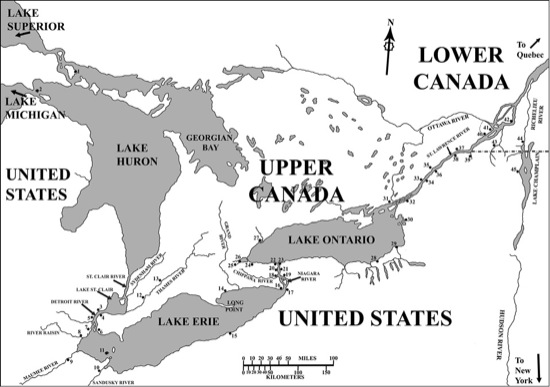CHAPTER 1
Introduction
Between 1808 and 1812, growing international tensions over a catalogue of issues pitted the United States and Great Britain against each other, leading to the spectre of war breaking out between the two nations; a circumstance actively endorsed by a group of political activists within the United States collectively known as “War Hawks.” Their goals finally came to fruition in the summer of 1812, when President James Madison signed the declaration of war on June 18, 1812. However, contrary to the prophetic boasts of these War Hawks, the desired war did not go smoothly toward a swift conclusion and the glorious victory they had expected. Instead, it dragged on and degenerated into a year and a half of half-baked campaigns and battlefield defeats at the hands of an alliance of British regular troops, Canadian militia units, and Native Allied warriors (hereafter, British or Allies). With embarrassing regularity, the inherent weaknesses of the pre-war American military structure revealed itself to include:

U.S. President James Madison.
Courtesy of the Buffalo and Erie County Historical Society Research Library, Buffalo, NY.

The “Northern Frontier” of the War of 1812–1815. (Modern Name) [Fortifications]
1. St. Joseph Island [Fort St. Joseph]
2. Michilimackinac Island (Mackinac) [Fort Mackinac/Fort Michilimackinac]
3. Detroit [Fort Detroit]
4.Sandwich (Windsor)
5. Monguagon/Maguaga
6. Amherstburg (Malden) [Fort Amherstburg]
7.Brownstown
8. Frenchtown
9. Perrysburg [Fort Meigs]
10. [Fort Stephenson]
11. Put-in-Bay
12. Moravianstown
13. Longwoods
14. Port Dover
15. Presque Isle (Erie, PA)
16. Fort Erie [Fort Erie]
17. Buffalo and Black Rock
18. Chippawa
19. [Fort Schlosser]
20. Queenston
21. Lewiston
22. Newark (Niagara-on-the-Lake) [Fort George, Fort Mississauga]
23. [Fort Niagara]
24. Stoney Creek
25. Ancaster
26. Burlington Heights (Hamilton, ON)
27. York (Toronto) [Fort York]
28. Sodus
29. Oswego [Fort Oswego]
30. Sackets Harbor [Fort Tompkins, Fort Volunteer, Fort Pike]
31. Kingston [Fort Frederick, Fort Henry]
32. French Creek
33. Elizabethtown/Brockville (1813)
34. Morrisburg
35. Prescott [Fort Wellington]
36. Ogdensburg
37. Crysler’s Farm
38. Hamilton (Waddington, NY)
39. French Mills
40. Coteau-du-Lac
41. Cedars
42. Montreal
43. Châteauguay
44. Îsle aux Noix
45. Plattsburg
- A senior field command structure principally made up of incompetents and/or geriatrics, appointed for their personal and political connections rather than battlefield expertise.
- A mid-level field command structure composed principally of keen but relatively inexperienced younger officers.
- A governmental administration of the military run by political appointees and insiders, who repeatedly interfered in every level of decision making and even altered the campaign decisions of the field commanders by issuing bureaucratic dictates from the safety of Washington.
- A field-level regular fighting force that was initially made up of inexperienced and half-trained troops, backed by a state militia system that ran upon a virtually independent and sometimes self-serving or competing series of objectives.
- A military supply system that was rife with administrative corruption and fraud, and suppliers that produced and sold substandard military goods at inflated prices and then regularly failed to deliver in time or in sufficient quantities to fulfill the needs of the troops.
While certain individual military commanders certainly did make substantial improvements in their own commands, nonetheless, by the end of 1813 the overall state of affairs in pressing their war aims was so bad that, on December 31, the American House of Representatives established a Congressional committee of inquiry “requesting such information (not improper to be communicated) as may tend to explain the causes of the failure of the arms of the United States on the Northern frontier …”[1] from the secretary of war, John Armstrong. A month later, Armstrong responded with a fifty-page document that included transcripts of letters and official reports that catalogued the military debacles at Detroit, Queenston, Frenchman’s Creek, Stoney Creek, Fort George, Fort Niagara, Black Rock, Buffalo, Châteauguay, and Crysler’s Farm (to name but a few). On the other hand, Armstrong’s report, while hinting at the issues outlined above, failed to present any real conclusions or recommendations as to how these failures could be remedied.
The previous books of this series, The Call to Arms, The Pendulum of War, and The Flames of War, have traced the course of those campaigns through 1812 and 1813, as it applied to the Northern frontier. For those who have not read these earlier works, the following is an abridged timeline of that period.

U.S. Secretary of War John Armstrong.
Courtesy of the Buffalo and Erie County Historical Society Research Library, Buffalo, NY.
TIMELINE
- June 17/18, 1812: [Washington] The U.S. Senate passes the vote to declare war on Great Britain. President Madison signs the declaration of war.
- July 12, 1812: [Detroit frontier] U.S. forces launch an invasion of Upper Canada at Sandwich (Windsor) that within weeks withdraws back to Detroit.
- August 16, 1812: [Detroit frontier] Allied forces under Major General Brock, supported by Native allies under Tecumseh, intimidate Brigadier General Hull into surrendering his entire garrison at Detroit.
- October 13, 1812: [Niagara frontier] The Battle of Queenston Heights. U.S. forces invade Upper Canada at Queenston. Major General Brock is killed while leading a counterattack. Later in the day, Major General Roger Sheaffe arrives with reinforcements and leads a successful flanking counterattack upon the American position, routing their line.
- November 28, 1812: [Niagara frontier] The Battle of Frenchman’s Creek. U.S. forces make a failed attempt to create a bridgehead for invasion at Fort Erie and Frenchman’s Creek.
- April 27, 1813: [Upper Canada] The Battle of York (Toronto). U.S. forces mount an amphibious attack and capture York (Toronto). As they retreat, the British explode their main magazine, inflicting heavy casualties on the American forces. In retaliation, the Americans burn the town’s public buildings (Parliament) and Fort York.
- May 1–9, 1813: [Detroit frontier] The Siege of Fort Meigs. Allied forces mount a pre-emptive campaign to destroy Fort Meigs. Although the siege fails, the expedition cripples American plans to mount a counter invasion upon western Upper Canada for several months to come.
- May 27, 1813: [Niagara frontier] The Battle of Fort George. U.S. forces mount an amphibious invasion on the Niagara frontier with an attack on Newark (Niagara-on-the-Lake). Defeated Allied forces are forced to abandon Fort George and retreat to Burlington Heights/Head-of-the-Lake (Hamilton).
- May 29, 1813: [Lake Ontario] The Battle of Sackets Harbor. Allied forces mount an unsuccessful amphibious attack on Sackets Harbor.
- June 6, 1813: [Niagara frontier] The Battle of Stoney Creek. Allied forces make a surprise night attack on advancing U.S. forces encamped at Stoney Creek. Although a tactical draw, the American invasion stalls and the Americans retreat to a militarized enclave around Fort George/Newark.
- June 24, 1813: [Niagara frontier] The Battle of Beaver Dams. U.S. forces being besieged at Fort George attempt a large-scale sortie to disrupt the British outpost at Beaver Dams. Lax security while on the march allows Laura Secord to bring word to the British, who use their Native allies to entrap and defeat the American sortie.
- July 11, 1813: [Niagara frontier] British forces attack and overrun the American positions at Black Rock.
- July 17, 1813: [Niagara frontier] U.S. forces make a strong probe on the British positions at the Crossroads (Virgil). This engagement represents the first significant action to include Native forces fighting on both sides.
- August 24, 1813: [Niagara frontier] British forces make a sortie against the American positions around Fort George.
- September 10, 1813: [Lake Erie] The Battle of Lake Erie. American naval forces defeat and capture the British squadron on Lake Erie.
- September 23, 1813: [Detroit frontier] Following the loss of the British fleet on Lake Erie and in the face of an American invasion, British forces on the Detroit frontier are forced to destroy their fortifications and retreat north toward the Thames River, pursued by the Americans.
- October 5, 1813: [Upper Canada] The Battle of the Thames/Moraviantown. U.S. forces rout the retreating Allied forces and kill Tecumseh. Western Upper Canada now effectively falls under American hands, while the British continue their retreat to Burlington Heights.
- October 9, 1813: [Niagara frontier] British forces blockading Fort George abandon their positions and begin a retreat to Burlington Heights.
- October 26, 1813: [Lower Canada] The Battle of Châteauguay. U.S. forces invade Lower Canada, but are repulsed at Châteauguay.
- November 3, 1813: [St. Lawrence frontier] U.S. forces begin a campaign against Lower Canada by sailing an invasion fleet out of Lake Ontario into the St. Lawrence River, which is subsequently pursued by a British force.
- November 11, 1813: [St. Lawrence frontier] The Battle of Crysler’s Farm. U.S. forces are defeated by the British at Crysler’s Farm, effectively ending the attempted American campaign to attack Montreal.
- December 12, 1813: [Niagara frontier] U.S. troops at Fort George abandon the Canadian side of the Niagara River. Canadian renegades, fighting with the Americans, burn down Newark (Niagara-on-the-Lake).
- December 19, 1813: [Niagara frontier] The Capture of Fort Niagara. British troops cross the Niagara River and mount a surprise night-attack on Fort Niagara, capturing the fort.
- December 29, 1813: [Niagara frontier] The Assault on Buffalo. British forces attack and rout American troops at Buffalo, burning all military positions and civilian dwellings in retaliation for the previous American burning of Newark.
It is now the intention of this work, The Tide of War, to take up that story at the beginning of the winter of 1813–14 and begin the account of how the final year of the war developed in the fight to control Upper Canada, and in particular, how the already devastated lands bordering the Niagara River became the location for some of the hardest fought and bloodiest battles, as well as the longest siege recorded during the entire course of the North American War of 1812–15.
Richard Feltoe